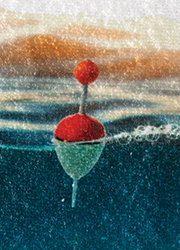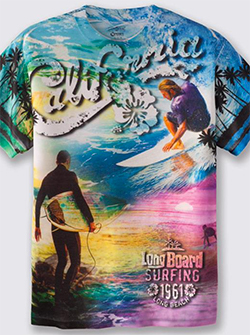Many customers at decoration shows I’ve worked in the last year are interested in learning about sublimation on apparel. At the shows, I see apparel companies that do all-over dye sublimation on t-shirts, bowling shirts, polos, bags and towels. You can customize team jerseys, dance uniforms and restaurant uniforms with this decoration technique.
 In most of these cases the sublimation process, in which dyes are molecularly bonded into the fabric fiber via the extreme heat process of 385 to 400 degrees, is performed on the fabric before the garment is assembled. This means that the design stretches along with the garment, will not crack, or fade over time. This contrasts with traditional screen printing in which ink is laid on top of the garment and topically bonds when cured through the dryer.
In most of these cases the sublimation process, in which dyes are molecularly bonded into the fabric fiber via the extreme heat process of 385 to 400 degrees, is performed on the fabric before the garment is assembled. This means that the design stretches along with the garment, will not crack, or fade over time. This contrasts with traditional screen printing in which ink is laid on top of the garment and topically bonds when cured through the dryer.
The process starts with your sublimation transfer paper, which is coated with special sublimation ink. When the transfer paper is pressed onto a substrate, it gets heated up to a specific heat (385-400 degrees) and with the right pressure the ink then transforms into a gas to bond with the fabric fibers. The heat serves two purposes in the process: to transform the ink into a gas and to open the pores of the fabric or substrate you are pressing the ink into.
After heating the sublimation transfer on the garment, with the correct pressure and cure time it will release the ink from the paper and transfer it to the fabric. Once cool, the sublimation ink will return to its solid state while the pores of the garment close, capturing the ink within the garment’s polymer coating.
 You have two dye sublimation options on finished assembled products pulled from stock: all-over and spot sublimation.
You have two dye sublimation options on finished assembled products pulled from stock: all-over and spot sublimation.
All-Over Dye Sublimation
This sublimation process allows for incredibly detailed designs that can utilize every inch of the product — from seam to seam on the front and back, including the hems, sleeves, and collar. Unlike traditional screen printing, you are not limited to a certain screen size, and you can use any color, font, text size, gradient, and effect you can dream of. All-over sublimation also allows for customization of player names and numbers and any placement you like.
Due to the high temperature involved in the sublimation process, it’s important to remember to use fabrics with high polyester content that can withstand a lot of heat, like the PosiCharge Competitor Tee from Sport-Tek, and white is usually the best color to start with. Be aware that all-over sublimation can leave slight imperfections or creases of white where the ink was unable to bond, usually due to seam areas not being flat enough or sleeve areas under the arm.
Spot Sublimation
 95% of dye sublimation on stock product is done with spot sublimation. This works the same way and offers some of the benefits as full sublimation, except that designs are limited to certain sizes and locations on the flat areas of the garment. The drawback here is you must make sure the fabric can support these high temps or you might change the sheen around the design, leaving a halo effect.
95% of dye sublimation on stock product is done with spot sublimation. This works the same way and offers some of the benefits as full sublimation, except that designs are limited to certain sizes and locations on the flat areas of the garment. The drawback here is you must make sure the fabric can support these high temps or you might change the sheen around the design, leaving a halo effect.
You can spot sublimate on polos, tees, fleece, jerseys, shorts, trucker hats, towels and other items. Like all-over sublimation, the science of how this printing method works means that it can only be applied to 100% polyester apparel or at least a very high polyester content which can stand up to the extreme heat and pressure of the process. Most 100% polyester apparel cannot handle this process without being damaged in some measure, so we always recommend testing a product first and consulting with your decorator or consumable supplier.
Here are some of the other products ideal for dye sublimation from SanMar:
- Jerzees Dri-Power 100% Polyester T-Shirt
- Port Authority Sublimation Beach Towel
- Port Authority Sublimation Rally Towel
There’s always something new happening in the world of apparel decoration. For more advice and best practices in this ever-evolving business, be sure to keep up with the Deco Talk blog and visit our Decorator and Digital Solutions page.
